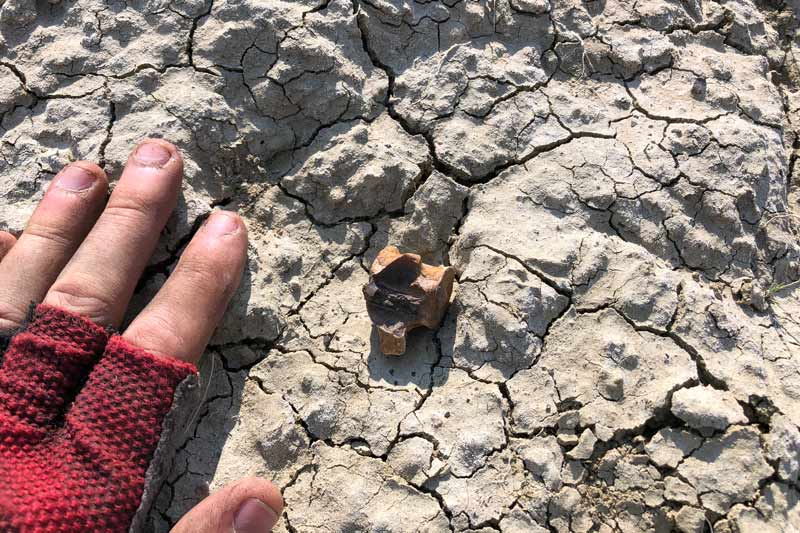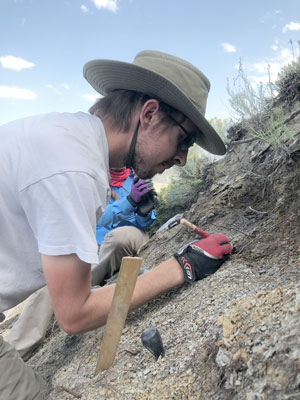
USask student finds rare ancient reptile skeleton in Saskatchewan
Palaeobiology student Jack Milligan uncovered the province's second-most complete fossilized skeleton of a champsosaur, a crocodile-like reptile that lived alongside the dinosaurs
By Chris Putnam
When Jack Milligan spotted the distinctive hourglass shape at his feet near Climax, Sask., he knew immediately what he was looking at.
“As a palaeontology student, your eyes are kind of glued to the ground whenever you’re walking because you never know if there’s a fossil where you’re going to step,” said Milligan, a student in his fourth year of undergraduate studies at the University of Saskatchewan (USask) College of Arts and Science.
Milligan was helping palaeontologists from the Royal Saskatchewan Museum and the Canadian Museum of Nature with field research in southwestern Saskatchewan on Aug. 22 when he noticed the small orange-coloured object.
It was the fossilized vertebra of a champsosaur: a large crocodile-like reptile that lived in and around swamps or rivers in the region about 66 million years ago. Milligan had discovered a piece of what would turn out to be the second-most complete champsosaur skeleton ever uncovered in the province.

Milligan has found champsosaur vertebrae in the past. “I didn’t think anything of it until I started finding a few more vertebrae, and then another one, and another one. I started wondering, okay, does this mean there is a skeleton nearby?” he said.
Dr. Emily Bamforth (PhD), a researcher with the Royal Saskatchewan Museum’s T.rex Discovery Centre and an adjunct professor in the USask Department of Geological Sciences, was supervising Milligan on the dig. She suggested he look for the source of the loose fossils in a nearby hillside.
Milligan soon located an area that “was just littered with champsosaur bones,” he said. “I was calling down to Emily, ‘There are limb bones and ribs and hip elements up here!’”

Together, over the next two days, they uncovered about 30 per cent of the reptile’s skeleton, including sections of ribs and a foot that were articulated—connected as they were during the animal’s life.
“I told Emily at one point, ‘I am trying to be professional right now, but on the inside I am screaming.’ I was just overjoyed that I found this champsosaur skeleton,’” said Milligan, who spent the last day of his trip piecing together the skeleton in a laboratory at the T.rex Discovery Centre in Eastend, Sask.
Champsosaurus lived alongside the dinosaurs of the Late Cretaceous period and outlasted them, surviving into the Paleogene period.
Champsosaur skeletons, especially those that are still articulated, “are very rare,” said Bamforth. The newly discovered skeleton is also important because it was found just above the layer of ground that marks the meteorite impact that wiped out the dinosaurs.
“It tells us something significant about how ecosystems were recovering in the half-million years after one of the most significant extinction events in Earth’s history,” Bamforth said.
Milligan is completing the final term of his Bachelor of Science in palaeobiology remotely from his hometown of Calgary, Alta. After graduation, he hopes to continue working with Saskatchewan fossils by pursuing a master’s degree at USask.
He has spent his summers volunteering at dig sites, networking with researchers and working for museums including the T.rex Discovery Centre.
“I knew that if I wanted to become a palaeontologist after undergrad, that I would need to have some experience going forward so that I could tell people I would potentially work with, ‘Hey, I’ve been to the field, and I’ve found all this stuff,’” said Milligan.

Milligan intends to be closely involved with his discovery going forward. He hopes to work with Bamforth on assembling the rest of the skeleton and studying the bones to learn more about how the creature lived and died.
Next summer, Milligan plans to return to the dig site with Bamforth to search for more pieces of the champsosaur, including its missing skull.
“I don’t care if I get sunburn or mosquito bites or anything like that. I endure it all for the thrill of the discovery of new fossils,” said Milligan.


